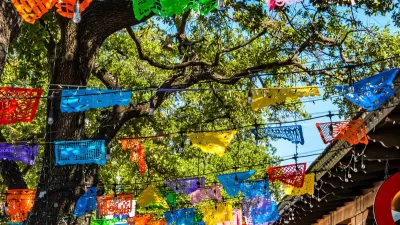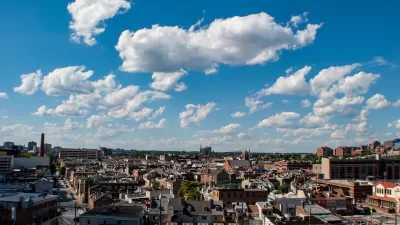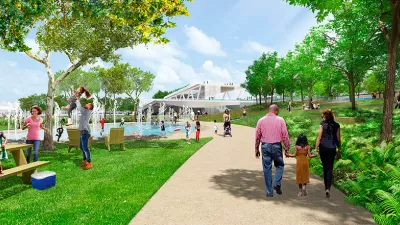Art and culture tend to be integral to helping disenfranchised communities self-identify, develop their identities, and organize around place-based issues. But its presence can also be used be used by real estate interests to market neighborhoods.
“On the west side of Prospect Park in Brooklyn, the neighborhood has been predominantly West Indian, but it’s changing. Maybe four [or] five years ago, there was an RIP mural that has been there for as long as I can remember, 15 to 20 years, and it was of a young black man who had gotten shot by a cop. And overnight, literally, overnight, some artist—I would presume someone new to the community—created a mural over that piece that was of a white girl catching a butterfly. The community—as you might imagine—was outraged, like, ‘we didn’t ask for this.’
It was a really bold statement, and it was interpreted as, ‘We’re here. We’re taking this place.’
All art is propaganda. It was a beautiful piece, and was executed really well, but was in such poor taste, and was a blatant disrespect to the community that folks—after graffiti-ing the [expletive] out of it—painted over it. I think the painting over it could be interpreted as, ‘No you don’t. You don’t get to do that. We may not be able to control [when] the rents go up, or who landlords are allowing into their building, but you can’t start to now, literally, change the face of public art in this community.’”
—Patrick Dougher, Groundswell
In the past, in historically disenfranchised neighborhoods that were tapped for new development, artist in-movers were sometimes considered the “first wave” in the gentrification process. Usually in the form of galleries, their spaces attracted newcomers of a different socio-economic group than neighborhood residents, which encouraged more newcomers and subsequent residential and commercial development.
In some neighborhoods, those spaces included non-commercial, community art spaces; and whether intentionally or not, their presence has been, and continues to be used by real estate interests to brand neighborhoods and make them more attractive to potential buyers. Like the Lower East Side of Manhattan in the 1980s, or Bushwick, Brooklyn today, the presence of an artistic community has hastened the chain reaction of higher income in-movers “discovering” a neighborhood, higher-end (and uncharacteristic to the neighborhood) commercial spaces opening, increased rent costs, and the displacement that follows. Unsurprisingly, resident hackles have been raised and sensitized to the appearance of galleries and other art spaces out of fear that displacement is in their future.
The other side of this reality is that art and culture tend to be integral to helping communities self-identify, develop their identities, and organize around place-based issues. Revolutionary organizations like the Black Panther Party in Oakland, art movements like Black Mask/Up Against the Wall Motherfucker, and community organizations like El Puente in Williamsburg and Banana Kelly in the South Bronx have all in one way or another used art to address local issues.
Because of the market and socio-political realities in New York City today, a lot of local issues often come back to gentrification and displacement, as they might have come back to redlining and the withdrawal of public services in the 1960s and 70s. And because talking about the presence of community art organizations and their effect on gentrification in New York City is largely a moot chicken/egg discussion, the task in most neighborhoods today is on lessening its effect. In a panel hosted this spring by arts organization Flux Factory and organized and moderated by its Column Shifting fellow Oksana Mironova, four representatives of New York City organizations discussed, among other topics, their employment of art and artists to empower residents in the face of gentrification.
FULL STORY: Art in the Face of Gentrification

Planetizen Federal Action Tracker
A weekly monitor of how Trump’s orders and actions are impacting planners and planning in America.

Maui's Vacation Rental Debate Turns Ugly
Verbal attacks, misinformation campaigns and fistfights plague a high-stakes debate to convert thousands of vacation rentals into long-term housing.

San Francisco Suspends Traffic Calming Amidst Record Deaths
Citing “a challenging fiscal landscape,” the city will cease the program on the heels of 42 traffic deaths, including 24 pedestrians.

Defunct Pittsburgh Power Plant to Become Residential Tower
A decommissioned steam heat plant will be redeveloped into almost 100 affordable housing units.

Trump Prompts Restructuring of Transportation Research Board in “Unprecedented Overreach”
The TRB has eliminated more than half of its committees including those focused on climate, equity, and cities.

Amtrak Rolls Out New Orleans to Alabama “Mardi Gras” Train
The new service will operate morning and evening departures between Mobile and New Orleans.
Urban Design for Planners 1: Software Tools
This six-course series explores essential urban design concepts using open source software and equips planners with the tools they need to participate fully in the urban design process.
Planning for Universal Design
Learn the tools for implementing Universal Design in planning regulations.
Heyer Gruel & Associates PA
JM Goldson LLC
Custer County Colorado
City of Camden Redevelopment Agency
City of Astoria
Transportation Research & Education Center (TREC) at Portland State University
Jefferson Parish Government
Camden Redevelopment Agency
City of Claremont





























